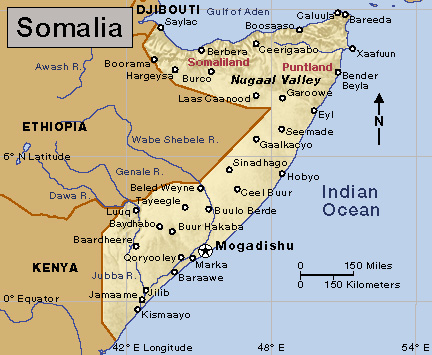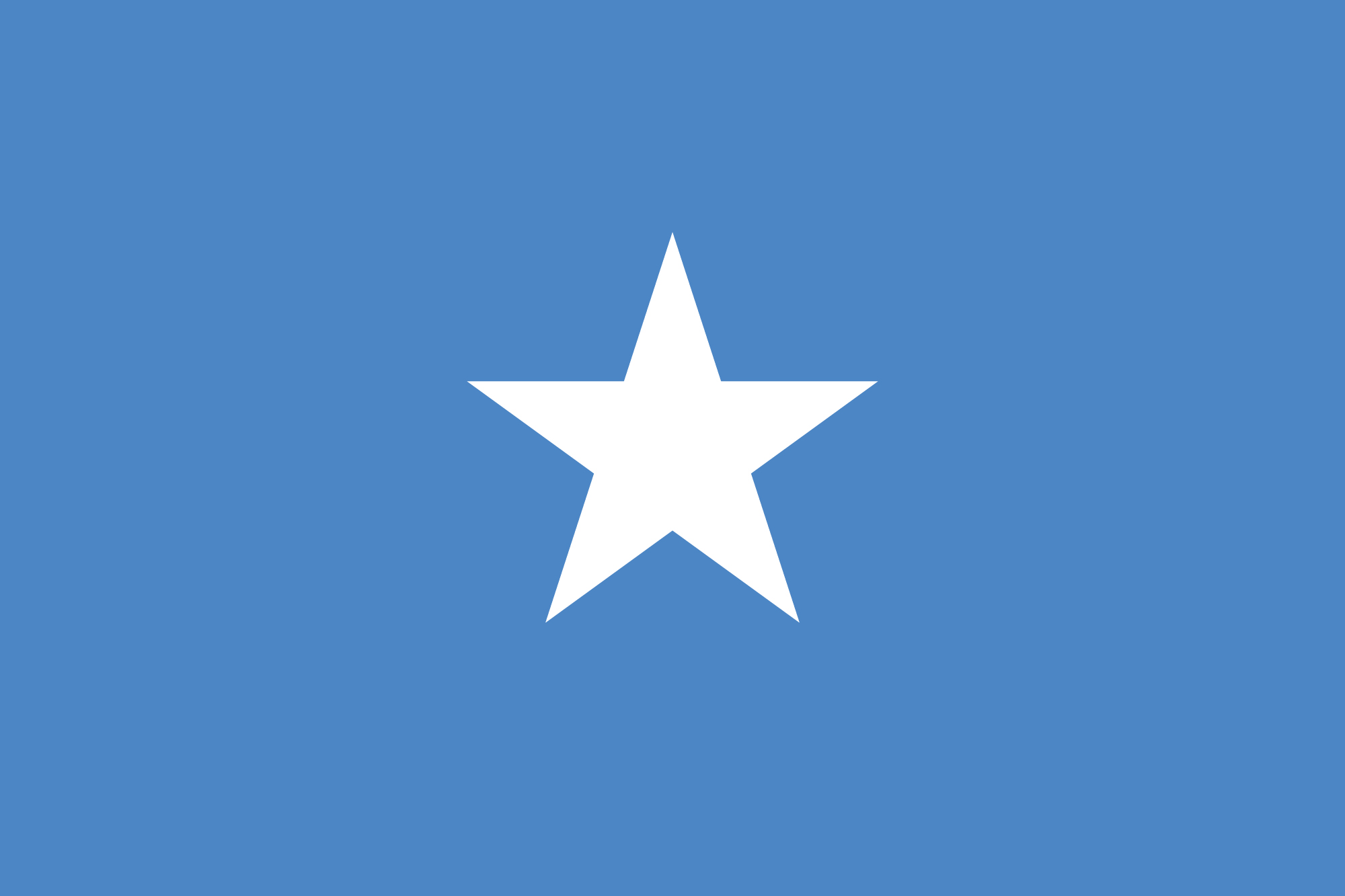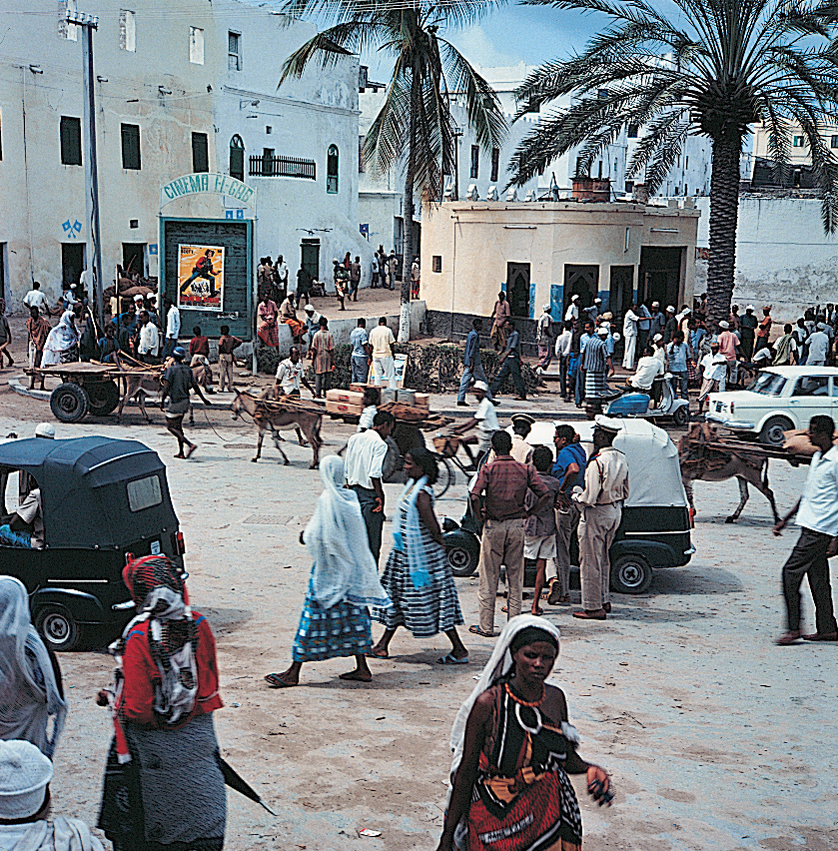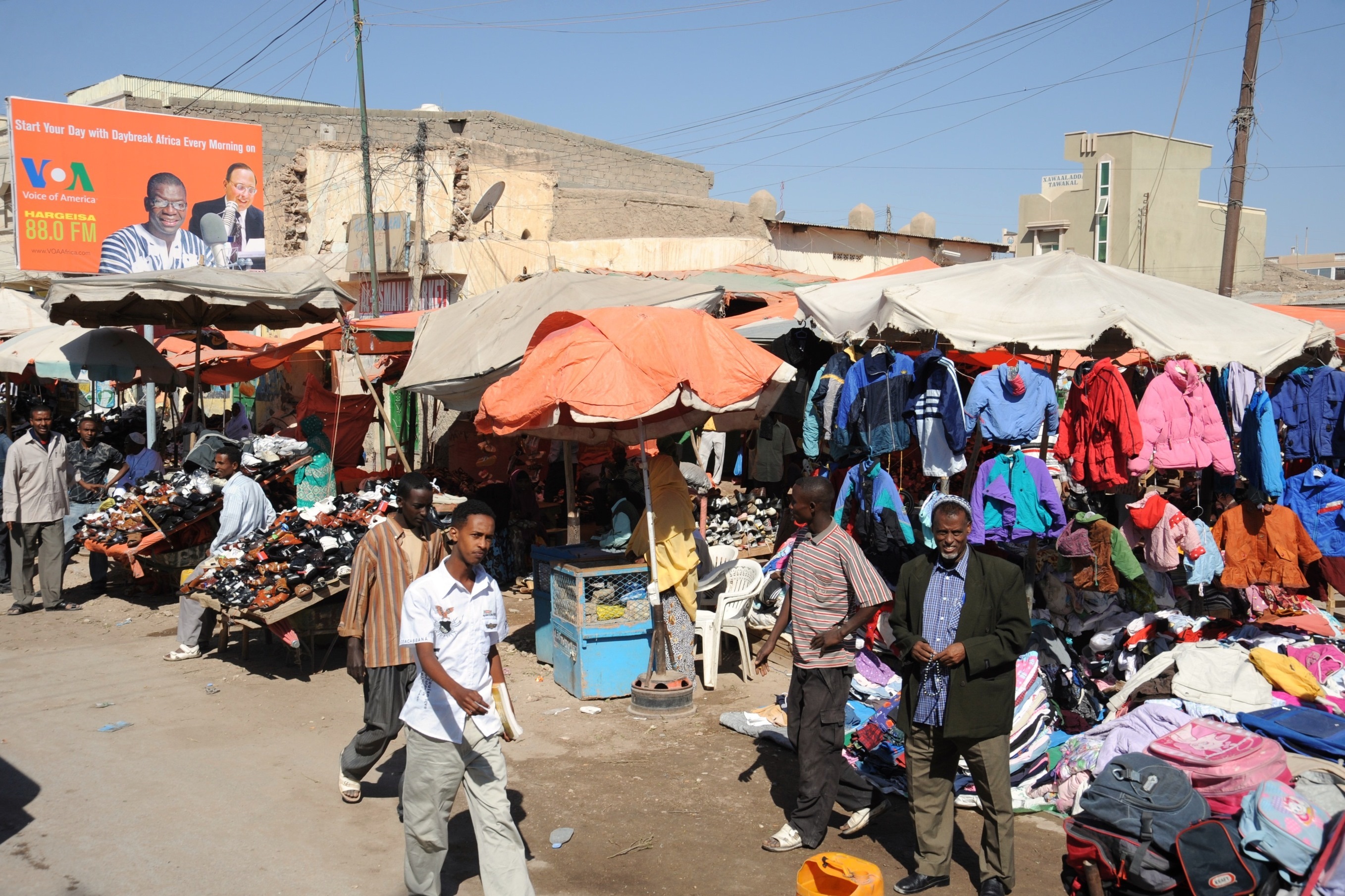Somalia << soh MAH lee uh or soh MAHL yuh >> is the easternmost country on the mainland of Africa. Its coastline, which runs along the Gulf of Aden and the Indian Ocean, forms the outer edge of what is known as the horn of Africa.

Almost all of Somalia’s people are Sunni Muslims and speak the Somali language. Somalia’s capital and largest city is Mogadishu. The country’s official name is the Somali Democratic Republic. Somalia became an independent nation in 1960. Before then, the United Kingdom ruled the northern part, and Italy ruled the south.
Government.
Somalia has not had an effective central government since rebels overthrew the country’s military rulers in 1991. The rebels soon split into rival factions, with some factions establishing control over different regions. The northern part of Somalia declared independence as Somaliland in 1991, but no country yet recognizes its independence.
In 2012, a transitional government approved a provisional constitution, and a new government came to power later that year. A new two-house parliament was first elected in 2016 and a new president was elected in 2017. Today, the parliament consists of the Senate and the House of the People. The members of the Senate and the House of the People both serve four-year terms. The parliament elects a president to a four-year term. The president appoints a prime minister.

People.
About 95 percent of Somalia’s people share the same language, culture, and religion. But they are sharply divided according to traditional clan groupings. Most Somalis belong to one of four clans that together are known as the Samaal. The Samaal are primarily nomadic herders. Members of two other clans, called the Sab (or Saab), live along the rivers in southern Somalia. Most Sab are farmers. Many Somalis are loyal only to their clan, and fighting between clans has been common. People of Arab, Bantu, Indian, and Pakistani descent also live in Somalia. Somali is the official language, but Arabic, English, and Italian are also spoken.

Except for the coastlands, small trade centers, and cultivated areas, much of Somalia is unsettled. Nomads make up about half the population. They live in small, collapsible shelters that have arched wooden braces covered with skins and grass mats. Their chief foods are milk and camel and goat meat. They also eat rice and other grains. Many people in Somalia drink tea.
In much of Somalia, the people wear traditional clothing that consists of a piece of brightly colored cloth draped over the body like a toga. Many men wear a kiltlike garment called a lungi or a ma’owey. In the cities and towns, some people wear clothing similar to that worn in Europe and North America.
Less than one-fifth of all Somali children attend school. Most of Somalia’s adults cannot read or write.
Somali craftworkers make fine leather goods, such as handbags and dagger sheaths. The people enjoy soccer and other sports and games. Reciting poetry and chanting are favorite forms of entertainment. Many of the poems and chants tell of love, death, or war, or of a prized possession, such as a horse or camel.
Land and climate.
Dry, grassy plains cover almost all of Somalia. A mountain ridge rises behind a narrow coastal plain in the north. Altitudes in some parts of northern Somalia reach more than 7,000 feet (2,100 meters) above sea level. The flat central and southern areas of Somalia have an average altitude of less than 600 feet (180 meters) above sea level.
The average temperature ranges from 85 to 105 °F (29 to 41 °C) in northern Somalia, and from 65 to 105 °F (18 to 41 °C) in the south. Average annual rainfall is approximately 11 inches (28 centimeters). Rainfall is seldom more than 20 inches (51 centimeters) a year, even in the south, the wettest region. Parts of the north receive only 2 to 3 inches (5 to 8 centimeters) of rain a year. In general, rain falls during two seasons—from March to May, and from October to December—but droughts occur frequently.
Most of the land in Somalia is generally suitable only for grazing livestock. However, in the south, two major rivers—the Jubba and the Shabeelle—provide water for irrigation. Farmers in this region grow crops.
Somalia has a wide variety of plant and animal life. Acacia thorn trees, aloes, baobabs, candelabras, and incense trees grow in the drier parts of the country. Such plants as kapok, mangrove, and papaya grow along the rivers. Wild animals include the crocodile, elephant, gazelle, giraffe, hippopotamus, hyena, and lion.
Economy.
Somalia has limited economic resources. Its economy has long been based on the herding of camels, cattle, goats, and sheep. During Somalia’s colonial period, Italian settlers established banana plantations along the Shabeelle and Jubba rivers. Somalis continue to grow such crops as bananas and sugar cane. Other crops include corn and sorghum.

Fishing employs some people, mainly in the north. Somalia has light industries such as sugar refining. The country has deposits of gypsum, iron ore, and uranium, but they have not been mined.
Somalia imports more than it exports. Imports include food, petroleum products, and vehicles. The country’s exports livestock and other agricultural products. Much of Somalia’s trade is with African and Middle Eastern countries.
Somalia has no railways, and the majority of its roads are unpaved. Travel is generally by truck or bus. A number of cities have airports. Mogadishu has an international airport.
History.
The land that is now northern Somalia was well known in the ancient world because of its location on a major trade route between the Mediterranean Sea and the lands to the east. During the A.D. 800’s or 900’s, Somalis began to move south from the Gulf of Aden coast, and Arabs and Persians began to establish settlements along the Indian Ocean coast. The Somalis were probably converted to Islam by about 1100.
Most of the Somali-inhabited area came under colonial rule in the 1800’s. In the mid-1880’s, the British took over much of northern Somalia, which became British Somaliland. The Italians gained control of most of the Indian Ocean coast in the 1880’s and 1890’s. They gradually advanced inland toward Ethiopia and established the colony of Italian Somaliland. In the early 1900’s, Somali nationalists led by Sayyid Muhammad Abdille Hassan fought against British, Italian, and Ethiopian forces.
Italy conquered Ethiopia in 1936. Italian Somaliland then became part of the Italian East African Empire, based in Ethiopia. In 1940, Italy entered World War II (1939-1945) and seized British Somaliland. But the British drove the Italians out of eastern Africa in 1941. A temporary British military administration was then set up in British Somaliland and Italian Somaliland. In 1948, Ethiopia regained control of an area with a large Somali population, historically called the Ogaden region.
In 1950, the United Nations (UN) ruled that Italian Somaliland should be placed in the care of Italy for 10 years, after which it was to become independent. At the same time, Somalis in British Somaliland were demanding self-government. In the summer of 1960, the United Kingdom and Italy granted their Somali territories independence. The two territories united to form the independent state of Somalia on July 1, 1960. The new government encouraged national expansion, particularly into the Somali-inhabited areas of Ethiopia, Kenya, and French Somaliland (now Djibouti). This action led to tension between Somalia and all three of its neighbors.
Somalia experienced economic difficulties, and many people claimed that only a small number of individuals and clans were benefiting from independence. These concerns prompted military officers, led by Major General Mohamed Siad Barre, to seize control of the government in 1969. All Somali land, transport systems, electrical plants, banks, schools, and medical services came under government control. Many of these changes took place in the midst of a serious drought in the mid-1970’s.
More problems followed when Somalia encouraged antigovernment Somali rebels in Ethiopia in 1974. Fighting broke out between Somalia and Ethiopia. In 1977 and 1978, Somali forces took over the Ogaden region of Ethiopia. But Ethiopian forces pushed back the Somalis, leaving Somalia militarily weak. In 1988, Ethiopia and Somalia signed a peace agreement, ending the fighting.
In 1991, a rebel group called the United Somali Congress (USC) overthrew Somalia’s military regime and took control of the capital. Fighting broke out in and around Mogadishu between USC factions. Other rebel groups gained power in other parts of Somalia. The Somali National Movement declared the independence of northern Somalia, calling it the Republic of Somaliland. But other countries did not recognize the area as a new nation.
The fighting in Somalia caused disruptions in food production and distribution, which, coupled with a drought, led to widespread starvation. Other countries and international relief groups sent food to Somalia. However, Somalia had no central government to protect the food, and armed criminals stole much of it.
By late 1992, about 270,000 Somalis had starved to death. The UN Security Council sent a coalition of military forces from several countries to Somalia. Led by the United States, the coalition provided security for relief organizations and helped get large amounts of food to the people who needed it.
In 1993, UN troops replaced most coalition forces. Mohammed Farah Aidid, a clan leader, accused UN officials of favoring his rivals, and his forces killed several UN peacekeepers. The UN then shelled Aidid’s headquarters in Mogadishu. Fighting between Aidid’s forces and UN troops, including U.S. forces, heightened the tensions in Somalia.
United States forces withdrew from Somalia in 1994 as part of a negotiated settlement. Rival clan leaders signed a peace accord at a UN-sponsored conference that year. The agreement called for a cease-fire and the formation of a transitional government. But fighting continued. In 1995, UN forces left Somalia. Talks held in 1997 also failed to stop the fighting. In 1998, the region of Puntland in northeastern Somalia declared itself an autonomous (self-governing) state.
A conference of about 2,000 Somali leaders elected a Transitional National Assembly for Somalia in 2000. The assembly elected a president. This government, however, had little control of the country outside Mogadishu. Several faction leaders refused to support the government and remained in control of parts of Somalia. Somaliland continued to claim independence, and both Somaliland and Puntland continued to maintain separate governments. In 2002, the Somali government and more than 20 faction leaders agreed to a cease-fire. But some fighting continued.
In the early 2000’s, pirates established bases in Somalia, taking advantage of the lack of effective government in the country. The pirates captured tankers, cargo ships, and civilian boats traveling in the Indian Ocean and the Gulf of Aden and held them for ransom. Many countries increased their naval presence off Somalia’s coast to combat the pirates and rescue captured vessels.
In 2004, Somali politicians and the major faction leaders signed an agreement in Kenya to establish a new Transitional Federal Government (TFG). Somaliland did not participate, but Puntland did. A new Transitional Federal Parliament was created later that year. The parliament elected Abdullahi Yusuf Ahmed, Puntland’s leader, as president of Somalia. The transitional government operated from Kenya until 2005.
In 2006, the parliament met in Somalia for the first time. The members met in the town of Baydhabo (also called Baidoa) to avoid violence in Mogadishu. By midyear, militias of the Islamic Courts Union (ICU) movement had taken control of Mogadishu by force. The ICU ruled the city using a version of the Sharī`a (Islamic law). They gradually gained control of most of southern Somalia. Ethiopia sent troops to assist the TFG government. With Ethiopia’s help, the government was able to establish itself in Mogadishu, and the leaders of the ICU fled the country. However, many Somalis resented the presence of Ethiopian troops in their country, and some clans began fighting against them.
In 2007, the African Union (AU)—an organization that promotes cooperation among African governments and peoples—began sending peacekeeping forces into Somalia. Occasional fighting continued, between Ethiopian and AU troops, ICU militias, and clan factions. President Yusuf resigned in 2008.
In 2009, Ethiopian troops began to pull out of Somalia. They were replaced by AU troops, though fighting continued. Somalia’s parliament elected Sharif Sheikh Ahmed, a leading figure in the ICU, as president. Midyear, the president declared a state of emergency due to an increase in rebel violence. In late 2011, Kenya and Ethiopia sent troops into southern Somalia to help the government suppress the rebels.
In 2012, the transitional government approved a new provisional constitution and then was dissolved. Clan elders nominated members to a new parliament, which then elected former opposition leader Hassan Sheikh Mohamud as president.
In 2013, the Somalia-based Islamist extremist group al-Shabab attacked a shopping mall in Nairobi, Kenya, killing at least 67 people and injuring many others. In 2015, al-Shabab militants attacked a university in northeastern Kenya, killing 148 people. In both attacks, the extremists targeted Christians and let Muslims go free. Al-Shabab claimed the attacks came in response to Kenyan intervention in Somalia. In 2017, the Somali government blamed al-Shabab for a truck bomb attack that year in Mogadishu near the ministry of foreign affairs. More than 350 people were killed, hundreds of others were injured, and nearby buildings were destroyed. In early 2023, the leaders of Somalia, Djibouti, Ethiopia, and Kenya announced a joint military operation to defeat al-Shabab in Somalia.
In 2016, Somali clan elders chose delegates who then elected members to the lower house of parliament. Representatives from Somalia’s states elected members to a newly created upper house of parliament. In 2017, the members of the two parliamentary houses elected a new president, Mohamed Abdullahi Mohamed. In 2022, members of parliament elected former president Hassan Sheikh Mohamud to the presidency.
In 2020 and 2021, Somalia faced a humanitarian crisis as successive waves of billions of locusts swarmed East Africa. The locusts destroyed crops and pastureland, causing extreme food shortages and forcing thousands of people to flee their villages.
